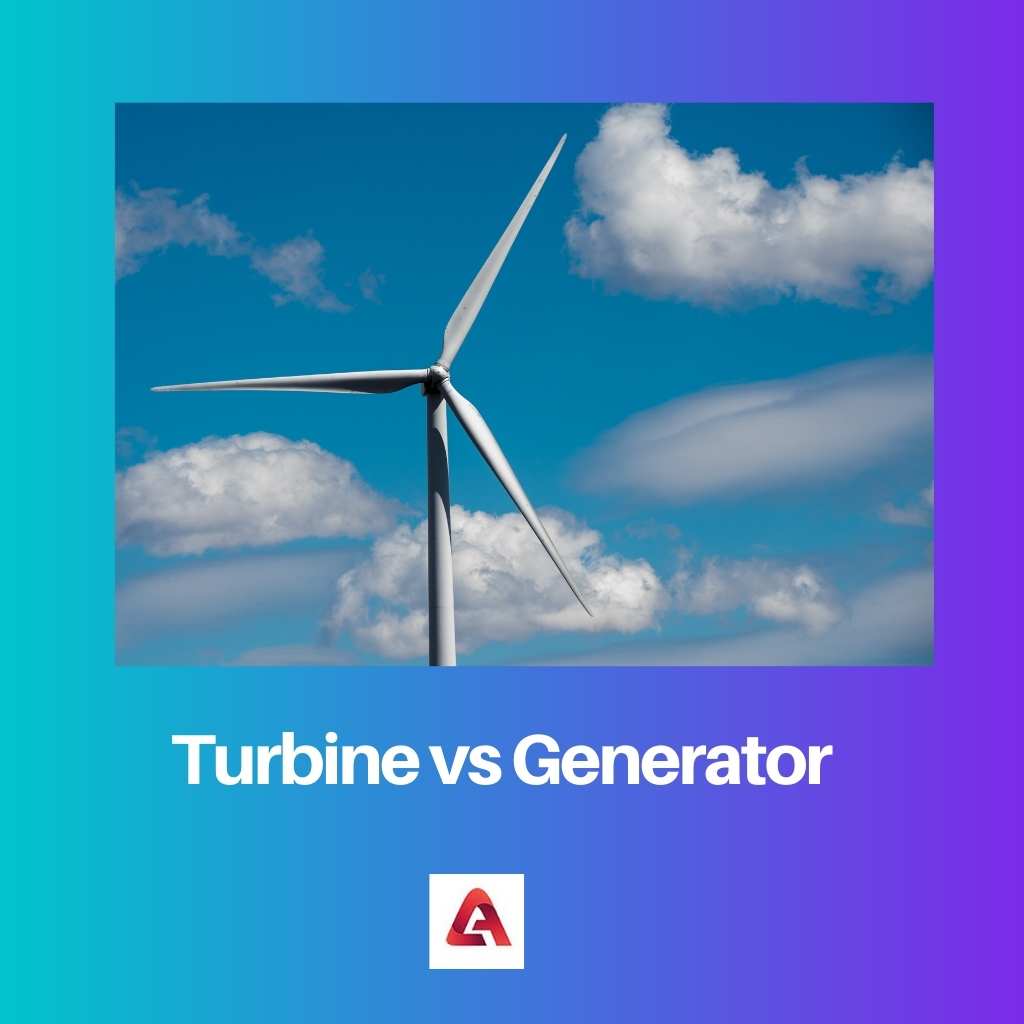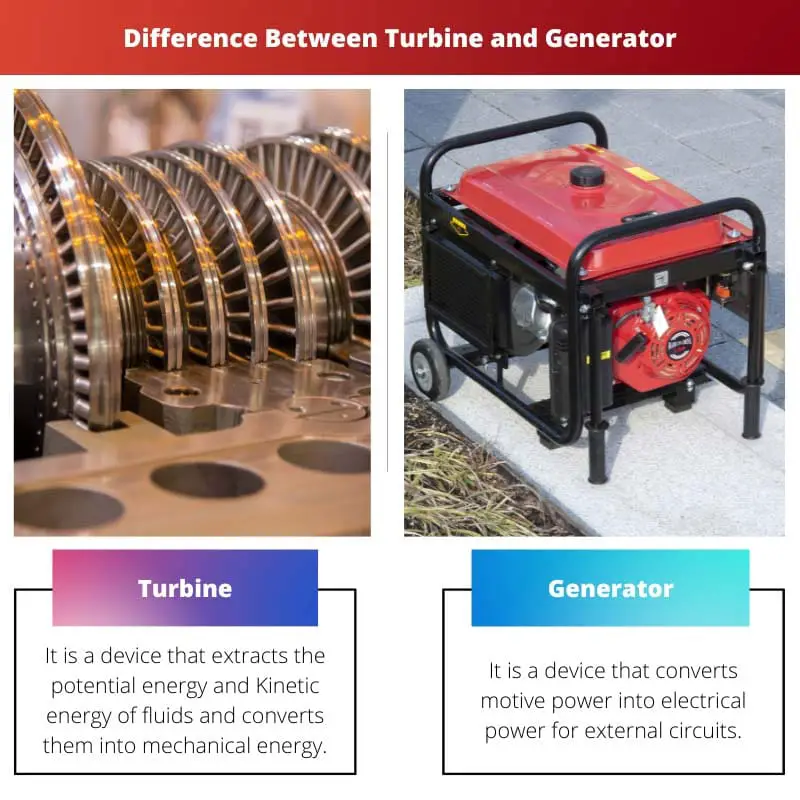With the advancement of technology in the modern period, the amount of electricity used has also increased marginally.
Despite the fact that electricity has been ingrained in our daily lives, we may be curious as to where it comes from.
It is created and then put to use in a productive manner. Turbines and generators are two examples of inventions by which power reaches us.
Key Takeaways
- A turbine is a machine that converts energy from fluids (such as water or steam) into mechanical energy. At the same time, a generator is a machine that converts mechanical energy into electrical energy.
- Turbines and generators are used together in power plants to generate electricity.
- Turbines come in various types, such as steam turbines, gas turbines, and hydraulic turbines, while generators can also vary in size and capacity.
Turbine vs Generator
A turbine is a device that converts the energy of a fluid (dam, stream, river, etc) into mechanical energy. The mechanical energy is then used to rotate a shaft. A generator converts the mechanical energy produced by the turbine into electrical energy for use in private or public places.

A turbine is a revolving component that turns the kinetic energy of a working fluid into mechanical and/or electrical energy that can be used.
A rotor is equipped with a set of blades that help extract energy from a moving fluid. The efficiency of turbines is determined by the blade design.
A generator generates electricity by revolving a turbine within a rotating metal frame.
The spinning action produces an electromagnetic field, which transforms mechanical energy into electrical energy.
Generators are thought to be inefficient and can result in energy loss in the form of mechanical energy.
Comparison Table
| Parameters of Comparison | Turbine | Generator |
|---|---|---|
| Definition | It is a device that extracts the potential energy and Kinetic energy of fluids and converts them into mechanical energy. | It is a device that converts motive power into electrical power for external circuits. |
| Working | Its blades rotate around a center shaft. Some elements (water, gas, or air) flow through the blades, causing them to spin, which powers the turbine shaft. | Generators consist of a central shaft which is mounted with magnets wound with wire. The rotation of the shaft causes the production of magnetic fields and the result is the generation of electrical current in the wires. |
| Types | Water turbine, Reaction Turbines, Impulse Turbines, wind turbine, Radial Flow Turbine | Diesel Generators, Gas Generators, Standby generators, Gasoline Generators, |
| Maintenance | Needs to be maintained 2-3 times a year | Needs to be maintained once a year |
| Applications | Produce electricity, produce power in various industries, burn natural gas to power vessels at sea, generate rotating power to turn airplane propellers | Generate power for power stations in the electrical grid, produce power for electric control systems and lights in aircraft, emergency generators are used in residential and commercial applications, smaller versions of generators referred to as alternators produce the electricity that charges the car battery |
What is Turbine?
A turbine is a machine that creates work by converting energy obtained from sources such as water and solar power into work.
It may be seen in many industries that act as environmentally friendly units to generate and utilize energy from endless resources like hydropower.
Because the energy generated by a turbine is directly turned to work, no energy is wasted.
In 1849, the first turbine was discovered. It was a water turbine that used the kinetic energy of water to generate electricity.
It was invented by James Francis, a British American engineer, and is also known as a hydro turbine.
Wind turbines and solar turbines were later developed to generate mechanical energy from the wind and sunshine, respectively.
The blade, rotor, and generator are the three primary components of a turbine.
The kinetic energy of water, steam, sunlight, and wind is converted into rotational energy by a turbine.
It is made up of a number of steel blades. It is used to generate power when connected to a generator.
Turbines generate enough energy by moving fluid around within a space and ensuring that the fluid crosses paths with all of the turbine’s blades.
Turbine blades are linked to a single point on the turbine’s central axle, which rotates with every motion.

What is Generator?
A generator, in most circumstances, has an engine or motor that rotates a magnet inside a wire coil.
Because electrons are spinning around the coil’s metalcore, the spinning action generates electricity in the coil.
Generators are more efficient than alternators because they provide a constant voltage, whereas an alternator’s speed varies depending on how much power is utilized on the vehicle.
This means that generators are better for powering larger appliances in your house or workplace.
Engine, Alternator, Fuel System, Voltage Regulator, Cooling Systems, Lubrication System, Battery Chargers, and a Control Panel are the major components of a working generator.
These parts work together in a series of processes to generate electricity and transform it into useful energy.
Generators can be used for a variety of reasons.
Emergency generators, for example, are meant to give power to your house or office in the event of a power outage from the grid.
These generators can also be installed at your place of business to ensure that you have electricity in the event of a fuel oil-fired power plant’s emergency shutdown.
One of the most significant disadvantages of generators is that they do not conserve energy.
Instead, all of the power supplied by a socket or other energy source is absorbed and used to convert mechanical energy, even if that much power isn’t required.

Main Differences Between Turbine and Generator
- Turbines extract the potential energy and Kinetic energy of fluids and convert them into mechanical energy, whereas a generator converts motive power into electrical power for use in an external circuit.
- The main components of a turbine include blades, but the main components of a generator include wires and coils.
- The types of turbines include Steam, gas, water, and wind, whereas portable, inverter, and standby are types of generators.
- Turbines require more maintenance in a year as compared to generators.
- Turbines are used to burn natural gas to power vessels at sea generate rotating power to turn airplane propellers, but generators are only used to produce electricity.

References
- https://ieeexplore.ieee.org/abstract/document/849122/
- https://ieeexplore.ieee.org/abstract/document/5285378/
